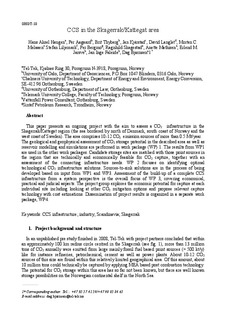CCS in the Skagerrak/Kattegat area
Haugen, Hans Aksel; Aagard, Per; Thyberg, Brit Inger; Kjärstad, Jan; Langlet, David; Melaaen, Morten Christian; Liljemark, Stefan; Bergmo, Per Eirik Strand; Skagestad, Ragnhild; Mathisen, Anette; Jarsve, Erlend Morisbak; Faleide, Jan Inge; Bjørnsen, Dag
Journal article, Peer reviewed
Accepted version
Permanent lenke
http://hdl.handle.net/11250/2438537Utgivelsesdato
2011-04-01Metadata
Vis full innførselSamlinger
Originalversjon
Energy Procedia 4 (2011) s. 2324-2331Sammendrag
This paper presents an ongoing project with the aim to assess a CO2 infrastructure in the Skagerrak/Kattegat region (the sea bordered by north of Denmark, south coast of Norway and the west coast of Sweden). The area comprises 10-12 CO2 emission sources of more than 0.5 Mt/year. The geological and geophysical assessment of CO2 storage potential in the described area as well as reservoir modelling and simulations are performed in work package (WP) 1. The results from WP1 are used in the other work packages. Candidate storage sites are matched with those point sources in the region that are technically and economically feasible for CO2 capture, together with an assessment of the connecting infrastructure needs. WP 2 focuses on identifying optimal technological CO2 infrastructure solutions. Sources-to-sink solutions are in the process of being developed based on input from WP1 and WP3. Assessment of the build-up of a complete CCS infrastructure from a system perspective is the overall focus of WP 3, covering economical, practical and judicial aspects. The project group explores the economic potential for capture at each individual site including looking at other CO2 mitigation options and propose relevant capture technology with cost estimations. Dissemination of project results is organized in a separate work package, WP4.
Beskrivelse
NOTICE: this is the author's version of a work that was accepted for publication in Energy Procedia. Changes resulting from the publishing process, such as peer review, editing, corrections, structural formatting, and other quality control mechanisms may not be reflected in this document. Changes may have been made to this work since it was submitted for publication. A definitive version was subsequently published in ENERGY PROCEDIA, VOL 4, (2011) DOI http://dx.doi.org/10.1016/j.egypro.2011.02.123
